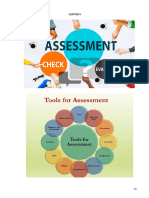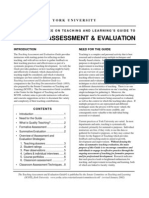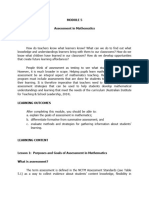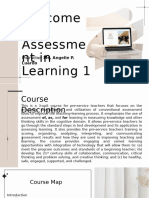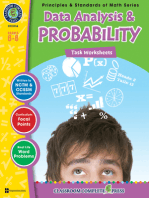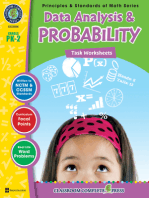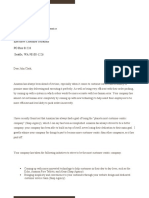Udl - Tips For Assessment
Udl - Tips For Assessment
Uploaded by
api-675699033Copyright:
Available Formats
Udl - Tips For Assessment
Udl - Tips For Assessment
Uploaded by
api-675699033Original Title
Copyright
Available Formats
Share this document
Did you find this document useful?
Is this content inappropriate?
Copyright:
Available Formats
Udl - Tips For Assessment
Udl - Tips For Assessment
Uploaded by
api-675699033Copyright:
Available Formats
UDL Tips for Assessment
In CAST’s Universal Design for Learning: Theory and Practice, assessment is defined as
“the process of gathering information about a learner’s performance to make educational
decisions” (Salvia & Ysseldyke, 2009). Universal Design for Learning (UDL) encourages
“assessment by design,” but what does that mean specifically for educators?
How can you use the UDL framework to design and reflect on assessments — whether the
assessments are through remote learning environments or in a face-to-face experience?
Align assessments to learning goals.
When the learning goals are clear, the
Ask yourself:
assessments should align so they measure
whether learners have achieved the intended
• Are my learning objectives/goals clear?
goal. Design assessments alongside learning
goals so that you can ensure you are measuring • Does my assessment reflect and
the intended goals of your learning experience. measure the intended learning goals,
There can be flexibility in the assessment or are there additional components or
skills that are also being measured by
options when the construct, or focus for the
my assessment?
assessment, is clear.
Offer authentic opportunities for assessment.
Offering relevant, authentic options for
assessment can help learners transfer usable Ask yourself:
knowledge and understand the “what,”
the “how,” and the “why” of their learning. • In what ways do my assessments
Whether you are in a face to face setting or in engage learners in understanding
the authenticity and relevance of
a remote learning environment, ensure that
the content?
the assessment can be personally relatable
and culturally relevant. • How am I providing opportunities
for learners to apply new
knowledge to novel situations and
relatable experiences?
Assess engagement as well as content knowledge.
We know that engagement is essential for Consider a resource such as the Mood
learning. Assessing engagement in the learning Meter to build vocabulary and reflection
process can invite metacognitive reflection, so around emotion and engagement during
learners have the opportunity to assess their learning. It can be critical to develop this
own learning process. As part of the reflection kind of communication for remote learning,
process, assess and understand how learners as educators are not necessarily able to
engaged with and used resources strategically accurately evaluate learners’ engagement in
towards given demands in a task. the same ways in the remote context.
Ask yourself:
• How have I assessed learner engagement during the learning process?
• What strategies or supports helped a learner persist through a challenge to engage in
the assessment?
Include frequent formative assessments.
Formative assessments are ongoing, frequent Examples of formative assessments might
checks to measure learners’ progress toward include reflection questions on exit tickets,
the targeted learning goals. Data from “do now” questions, portfolio collections,
formative assessments should influence journal entries, or quick polls such as
instructional decisions and help determine how Plickers. Note that formative assessments
the options supported learners to achieve the should be incorporated in any learning
intended goals. experience, including remote learning.
Ask yourself:
• In what ways do my assessments engage learners in understanding the authenticity and
relevance of the content?
• How am I providing opportunities for learners to apply new knowledge to novel situations
and relatable experiences?
Reduce unnecessary barriers to access.
Assessments often have additional barriers or For example, options such as practice
challenges for learners that are not connected assessments, review guides, flexible timing,
with measuring the intended learning goal. assistive technologies, or support resources
Where possible, reduce the barriers that do not can be made available for all learners.
tie to the learning goals you want to measure.
Ask yourself:
• Are there accessibility barriers my learners may encounter in my assessments?
• What are the targeted skills or understandings this assessment is intended to measure?
• What may be preventing learners from showing what they know in my assessment?
Support learner variability through flexible assessments.
In any assessment, we can anticipate variability For example, assessments should reflect
in how our learners engage, are prepared, and the learning experience. Just as we use the
can show what they know. Flexible options UDL framework to design our lessons, the
not only enhance access, but can also reduce UDL principles (provide multiple means of
perceived threats or distractions and ensure all engagement, representation, and action and
learners are able to demonstrate their skills. expression) should also guide the design of
our assessments.
Ask yourself:
• What is some of the variability I can anticipate in my learners, especially during
assessments?
• How do the flexible options for engagement, representation, and action and expression in
my assessments align to the intended learning objectives and support learner variability?
Use and share rubrics to clarify expectations.
Rubrics are effective in making the goals and
expectations of an assignment explicit. They can Ask yourself:
serve as a baseline for what is required and then
can include opportunities for learners to add • Does the rubric align to the intended
goals they have for a given assignment. Clear skills or knowledge?
communication of expectations through a rubric • Are there opportunities for learners
can allow for consistent measurement of the to contribute to the rubric in ways
intended goal. that are meaningful to them?
Involve learners in assessing their learning progress.
Communicate with learners about their
progress towards the intended learning goals Ask yourself:
through formative assessment data, mastery-
oriented feedback, and providing guidance for • Have I offered timely, goal-related
possible adjustments or new strategies that may feedback for my learners on the
support the intended goal. This allows learners assessment?
to become active advocates and take ownership • Have I offered opportunities for
of their learning. learners to assess their own progress
and process (for example, through
regular check-ins)?
Reflect on summative assessments for future design.
Summative assessments focus on learner
performance after instruction has occurred, Ask yourself:
such as unit exams, course summative tests,
final project artifacts, or chapter summaries. • What kinds of summative
They are often used for accountability purposes, assessments am I using to measure
criterion for admittance, or to compare learner the learning outcomes for this
performance. Summative assessments can also learning experience?
be used to reflect on ways to improve learning • What are the summative
strategies and to further design goal-directed assessments measuring and how can
learning environments. that data be used to inform my future
instructional design?
Build communities of practice that support
reflective design.
Both formative and summative assessments
can be used to reflect on the purpose and Ask yourself:
effectiveness of instructional materials
and learning strategies. Collaborating with • How do I collaborate with other
colleagues around these assessment topics, educators to design effective
instruction and curricular materials
collecting and analyzing data, discussing
that support the targeted learning
outcomes, examining challenges, and
goals as measured through the
recommending solutions can be both effective
assessments?
and empowering. Find ways to have these
important discussions, whether together • In what ways do our teams or
departments adjust instruction or
during team meetings or through remote and
curricular decisions after evaluating
online platforms.
assessment results/ data?
Additional Resources
• UDL Instructional Planning Process from the UDL-IRN
• UDL and Assessment from CAST’s UDL on Campus
• A Policy Reader in Universal Design for Learning
by David Gordon, Jenna Gravel, and Laura Schifter
• Universal Design for Learning: Theory and Practice
by Anne Meyer, David H. Rose, and David Gordon
• Using Formative Assessment to Improve Student Achievement in the Core Content Areas,
a briefing paper from the Southeast Comprehensive Center at SEDL
• UDL Quick Tips from the ACCESS Project at Colorado State University
• Just Write! Guide from TEAL (Teaching Excellence in Adult Literacy)
Reference
Salvia, J., Ysseldyke, J.E. & Bolt, S. (2009). Assessment in special and inclusive education. (11th edition).
Boston: Houghton Mifflin Company.
You might also like
- Interim Guidelines For Assesment Under The New Normal: DEPED ORDER No. 31 S. 2020Document62 pagesInterim Guidelines For Assesment Under The New Normal: DEPED ORDER No. 31 S. 2020xanne92% (50)
- Bee Hotel Lesson PlanDocument5 pagesBee Hotel Lesson Planapi-483166155No ratings yet
- Developments in English For Specific Purposes. A Multi-Disciplinary Approach Tony Dudley-Evans and Maggie Jo ST John. 1998Document4 pagesDevelopments in English For Specific Purposes. A Multi-Disciplinary Approach Tony Dudley-Evans and Maggie Jo ST John. 1998Irineu Cruzeiro33% (3)
- Unit 4Document6 pagesUnit 4Cynicarel Mae GestopaNo ratings yet
- Preliminary Concepts and Recent Trends: Lesson 1. What Is Educational Assessment?Document20 pagesPreliminary Concepts and Recent Trends: Lesson 1. What Is Educational Assessment?Sunshine Arceo100% (7)
- The Nature of Educational AssessmentDocument7 pagesThe Nature of Educational AssessmentArwin Arnibal100% (1)
- 20.02.ECCE Writing ScaleDocument1 page20.02.ECCE Writing ScaleDavid FontesNo ratings yet
- Udl - Tips For Developing Learning GoalsDocument5 pagesUdl - Tips For Developing Learning Goalsapi-675699033No ratings yet
- Topic 6 Establishing AssessmentDocument22 pagesTopic 6 Establishing AssessmentDemayy ChuanNo ratings yet
- Chapter V PEHDocument15 pagesChapter V PEHmalorenceaNo ratings yet
- Assessment Under The K To 12 For Private SchoolsDocument89 pagesAssessment Under The K To 12 For Private Schoolsrichard alicawayNo ratings yet
- Lesson 1Document27 pagesLesson 1arevalodal.psaueskwela.edu.phNo ratings yet
- TevguideDocument8 pagesTevguideSiva KumaravelNo ratings yet
- Module 12 - Assessment of Student Learning SupplemetalDocument28 pagesModule 12 - Assessment of Student Learning SupplemetalRachelle malnawaNo ratings yet
- ChapterDocument17 pagesChapterAnas AhmedNo ratings yet
- Chapter 1introduction To Assessment in Learning 2Document39 pagesChapter 1introduction To Assessment in Learning 2LEOLANDA BALILLANo ratings yet
- Monday - Assessment of Student Learning 2Document53 pagesMonday - Assessment of Student Learning 2jonlester malanaNo ratings yet
- Day 5 Eman LCT AssessmentDocument84 pagesDay 5 Eman LCT AssessmentMiyNo ratings yet
- Deped Order 31 s2020 - LAC Session Group 2 - March 5 2021Document37 pagesDeped Order 31 s2020 - LAC Session Group 2 - March 5 2021bhoger calandriaNo ratings yet
- Experiential Learning 5Document19 pagesExperiential Learning 5MARISOL SALESNo ratings yet
- Revisiting The Assessment Policies and Standards - Topic1 AP SeminarDocument46 pagesRevisiting The Assessment Policies and Standards - Topic1 AP SeminarJessper Bryan SarmientoNo ratings yet
- Week 13 Interaction Between Curriculum, Instruction, and AssessmentDocument28 pagesWeek 13 Interaction Between Curriculum, Instruction, and AssessmentVivid MagazineNo ratings yet
- Overview On AssessmentDocument55 pagesOverview On AssessmentTorreja JonjiNo ratings yet
- Lecture Two 26-07-2024 Concept of Assessment (2) (Autosaved) (Autosaved)Document26 pagesLecture Two 26-07-2024 Concept of Assessment (2) (Autosaved) (Autosaved)manqobak60No ratings yet
- ICE Prioritization Brainstorm PresentationDocument112 pagesICE Prioritization Brainstorm Presentationnika marl TindocNo ratings yet
- OBE - EvaluationDocument21 pagesOBE - EvaluationMachino ChelseaNo ratings yet
- Assessment Test 6.04Document69 pagesAssessment Test 6.04Jamtsaa Leo BatboldNo ratings yet
- Lesson 2Document24 pagesLesson 2Sarayin J AgangNo ratings yet
- Differentiated AssessmentDocument18 pagesDifferentiated Assessmentapi-228264674100% (1)
- MODULE 5 Teaching Math in The Primary GradeDocument21 pagesMODULE 5 Teaching Math in The Primary GradeAYALA CARACTERNo ratings yet
- The Effective Approaches To Assessment That We Are Using in Our Milieu AreDocument4 pagesThe Effective Approaches To Assessment That We Are Using in Our Milieu AreShubha Jain100% (1)
- Assessment StrategiesDocument57 pagesAssessment Strategiessani hammadNo ratings yet
- Chapter 1Document41 pagesChapter 1ejat ejatNo ratings yet
- Educational AssessmentDocument3 pagesEducational AssessmentReymie Manio GrijaldoNo ratings yet
- Pt. 1 ASL 1 SY 24 25Document23 pagesPt. 1 ASL 1 SY 24 25hiimleoNo ratings yet
- iNTRO-TO-CLASSROOM-ASSESSMENT and RubricsDocument66 pagesiNTRO-TO-CLASSROOM-ASSESSMENT and RubricsJESSE CAPINNo ratings yet
- Student Learning Assessment: Options and Resources The Handbook at A GlanceDocument8 pagesStudent Learning Assessment: Options and Resources The Handbook at A GlanceKalel Jerus GabrielNo ratings yet
- Constructive Allignment. Assessment, T& LDocument30 pagesConstructive Allignment. Assessment, T& LAimi AliasNo ratings yet
- Assessment and EvaluationDocument66 pagesAssessment and EvaluationMagda Edith Castro ZegarraNo ratings yet
- Phases of Curriculum DevelopmentDocument20 pagesPhases of Curriculum DevelopmentAndrea May PolvorosaNo ratings yet
- Differentiated Assessment PDFDocument18 pagesDifferentiated Assessment PDFapi-264021425100% (3)
- Clackamas CC Assessment Presentation 2010Document47 pagesClackamas CC Assessment Presentation 2010Terry DoyleNo ratings yet
- Group 2 Final 1Document81 pagesGroup 2 Final 1Aime RoswellNo ratings yet
- AssessmentDocument6 pagesAssessmentvuh455577No ratings yet
- Local Media6441198221213860014Document140 pagesLocal Media6441198221213860014Eissej Dawn EchonNo ratings yet
- Assignment 02....Document26 pagesAssignment 02....aliahmad28521No ratings yet
- Formative Assessment PresentationDocument34 pagesFormative Assessment Presentationapi-279184573No ratings yet
- Assessment of For As LearningDocument17 pagesAssessment of For As Learningsabeer muhsinNo ratings yet
- Formative Assessment How To GuideDocument14 pagesFormative Assessment How To GuideJason Wong Guo ShunNo ratings yet
- Ail 2 ReviewerDocument10 pagesAil 2 Reviewerkirbypiloto470No ratings yet
- Lesson 1 Basic Concepts and Principles in Assessing LearningDocument12 pagesLesson 1 Basic Concepts and Principles in Assessing LearningRovie SaladoNo ratings yet
- 8602 Solved Assign 1Document11 pages8602 Solved Assign 1Huma DawoodNo ratings yet
- Teaching Studies 2B Study Notes - Semester 2 ExamDocument71 pagesTeaching Studies 2B Study Notes - Semester 2 ExamGaongalelwe MontshoNo ratings yet
- Linking Instruction and AssessmentDocument12 pagesLinking Instruction and Assessmentthe simple lifeNo ratings yet
- The ARCS Model of Motivating LearningDocument3 pagesThe ARCS Model of Motivating LearningAcevedoNo ratings yet
- Narrative Creative Writing Skills English Presentation in Charcoal Colourful Fun StyleDocument29 pagesNarrative Creative Writing Skills English Presentation in Charcoal Colourful Fun StyleMila Grace TungalaNo ratings yet
- Ched Based Obe FrameworkDocument27 pagesChed Based Obe FrameworkTyrone O. GilNo ratings yet
- What Is A Teaching Practicum?Document10 pagesWhat Is A Teaching Practicum?a100% (1)
- Week 14Document46 pagesWeek 14Kent GarciaNo ratings yet
- SS14 ReviewerDocument13 pagesSS14 ReviewerAnthony Jovan Munoz Tan IINo ratings yet
- Empowering Growth - Using Proficiency Scales for Equitable and Meaningful Assessment: Quick Reads for Busy EducatorsFrom EverandEmpowering Growth - Using Proficiency Scales for Equitable and Meaningful Assessment: Quick Reads for Busy EducatorsNo ratings yet
- Paper 2 The Contextual Lens PlanDocument5 pagesPaper 2 The Contextual Lens PlanSPNo ratings yet
- The Impact of Digital Advertising and Social Media Intensity On Materialism: The Case of Algerian Young ConsumersDocument18 pagesThe Impact of Digital Advertising and Social Media Intensity On Materialism: The Case of Algerian Young ConsumersBelhadj TarekNo ratings yet
- A ReportDocument12 pagesA ReportMiriam EstefaniNo ratings yet
- Cel2106 SCL Worksheet 6 - Muhammad Affan Bin IshakDocument2 pagesCel2106 SCL Worksheet 6 - Muhammad Affan Bin IshakAlbert EnsteinNo ratings yet
- A Crash Course in Wikipedia EditingDocument1 pageA Crash Course in Wikipedia EditingMario RossiNo ratings yet
- Cognate Ele 2 (Act 10)Document3 pagesCognate Ele 2 (Act 10)Maricar Arieta AlimNo ratings yet
- English To Arabic - Google SearchDocument1 pageEnglish To Arabic - Google SearchMuzaffar BhatNo ratings yet
- Enterprise Medianet Quality of Service Design 4.0-Overview QoSIntro - 40Document48 pagesEnterprise Medianet Quality of Service Design 4.0-Overview QoSIntro - 40Anonymous cRxoHJ32QvNo ratings yet
- Developing Listening Skills - Your Body Language Can Shape Who You AreDocument3 pagesDeveloping Listening Skills - Your Body Language Can Shape Who You ArePaulaNo ratings yet
- Online-Safe ResumeDocument3 pagesOnline-Safe Resumeapi-572204493No ratings yet
- Slaters National Commercial Directory of IrelandDocument1,208 pagesSlaters National Commercial Directory of IrelandMatthew OrdoynoNo ratings yet
- Top Skills Professionals Need For Workplace SuccessDocument7 pagesTop Skills Professionals Need For Workplace SuccessColeen gaboyNo ratings yet
- Nurse Aide ResumeDocument7 pagesNurse Aide Resumebdg8b37x100% (2)
- CAPE Communication Studies 2003 P3 PDFDocument4 pagesCAPE Communication Studies 2003 P3 PDFIsmadth2918388No ratings yet
- Daily Lesson LOG: School Grade Level Teacher Learning Area Date/Time QuarterDocument4 pagesDaily Lesson LOG: School Grade Level Teacher Learning Area Date/Time QuarterJennyNo ratings yet
- Task 1 - InfographicDocument2 pagesTask 1 - InfographicHaposan SitumorangNo ratings yet
- Introduction To Business English - ReviewDocument36 pagesIntroduction To Business English - ReviewMINH QUÂN NGÔ phưng LinhNo ratings yet
- Lesson 1 Grooming PersonalityDocument12 pagesLesson 1 Grooming Personalityrahman shahNo ratings yet
- Amazon Appraisal LetterDocument2 pagesAmazon Appraisal Letterapi-566679296No ratings yet
- Ict Lesson 3Document12 pagesIct Lesson 3Alliah Gift ClimacosaNo ratings yet
- Ipcrf Development PlanDocument2 pagesIpcrf Development Planrenzo paratsa100% (2)
- College Lecture, EssayDocument2 pagesCollege Lecture, EssayAlejandroTapiaPNo ratings yet
- Introduction To English Syntax: 2 Semester 2011 by Yusep & FitriDocument45 pagesIntroduction To English Syntax: 2 Semester 2011 by Yusep & FitriLinh HuynhNo ratings yet
- استراتيجيات التعليم والتثقيف الصحيDocument71 pagesاستراتيجيات التعليم والتثقيف الصحيᗰOHAᗰẸᗪ HẸᗰᗪᗩNNo ratings yet
- Marketing Management AssignmentDocument10 pagesMarketing Management AssignmentmeetNo ratings yet
- Youtube As A Promotional Tool-For WebsiteDocument6 pagesYoutube As A Promotional Tool-For Websiteapi-210748177No ratings yet
- Why AnonymityDocument1 pageWhy AnonymityrudranshNo ratings yet









